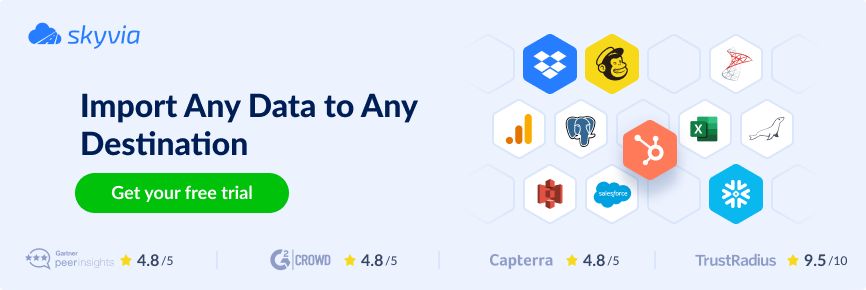Businesses always succeed by selecting the correct solution to work with data. The modern market offers many different ones, and it’s challenging to make the right choice, especially when talking about complicated tools like the Change Data Capture (CDC).
The CDC solutions are complex and have many pitfalls, so let’s define what businesses can take with this approach, what features are essential, what’s unnecessary, and so on. This article presents the top ten Change Data Capture tools for 2024 to help companies find the tool of their dreams.
Table of Contents
- What are the Change Data Capture (CDC) Tools?
- Why Do You Need CDC Tools?
- Benefits of Change Data Capture Tools
- Challenges and Considerations CDC Tools
- Best CDC Tools for 2024
- Conclusion
What are the Change Data Capture (CDC) Tools?
The CDC method automatically identifies and captures changes made to data in a database or source system in real-time or near real-time, like:
- New entries
- Updates
- Deletions
It facilitates replicating these changes to other systems, databases, or applications for data integration, synchronization, and analytics, avoiding bulk data load operations.
In other words, this approach helps to move high-volume data across multiple data systems and keep cloud DB’s architecture up to date.
Let’s see how it works in the business reality. Imagine an e-commerce company using an operational database (e.g., PostgreSQL) to manage its online transactions, including orders, customer details, inventory levels, and pricing information (they also got a DWH with a copy of their data). They must ensure that the data in their data warehouse is always up-to-date with the latest transactions and changes happening in the operational database. This synchronization must occur in real-time or near-real-time to support timely decision-making and reporting.
What they did:
- Implemented a CDC solution to monitor the operational database for any changes, including new transactions, customer records updates, inventory level changes, and product pricing modifications.
- As transactions occur throughout the day (e.g., a customer places a new order, updates their shipping address, or a product’s inventory level changes), the CDC tool detects these changes in the operational database. This detection includes capturing new rows inserted, updates made to existing rows, and rows that have been deleted.
- The CDC tool captures these changes and temporarily stages the changed data, often transforming it into a format suitable for the data warehouse (e.g., converting data types or restructuring data to match the warehouse schema).
- The staged changes are streamed to the data warehouse in real-time or near-real-time. The CDC tool ensures that these data changes are applied to the corresponding tables in the data warehouse, maintaining consistency and integrity.
- With the data warehouse continually updated through the CDC, the e-commerce company can run real-time analytics and generate up-to-the-minute reports. For example, they can immediately analyze the impact of a promotional campaign on sales, monitor inventory levels in real-time to prevent stockouts, and update financial forecasts based on the latest transaction data.
Why Do You Need CDC Tools?
To answer why you need CDC tools in your company life, let’s review how they may help your business.
| Need | Why It’s Needed | CDC’s Role |
|---|---|---|
| Real-Time Data Synchronization | Businesses require up-to-date data across systems for accurate analytics and timely decision-making. | CDC tools ensure continuous and immediate synchronization of data changes, keeping all systems current. |
| Efficient Data Integration | Traditional batch processing methods can be slow and consume excessive resources, leading to data latency. | By capturing only the changed data, CDC reduces the volume of data transfer, leading to more efficient integration. |
| Operational Efficiency | Manual data replication processes are resource-intensive and prone to errors. | Automation of data capture and replication with CDC minimizes manual efforts and system load, enhancing efficiency. |
| Support for Event-Driven Architecture | Modern applications benefit from reacting in real-time to data changes for more dynamic interactions. | CDC detects data changes and triggers events in real-time, facilitating complex, responsive architectures. |
| Data Consistency and Quality | Accurate analytics and operations require consistent data across all platforms and systems. | CDC helps maintain consistency by replicating every change from source to target, improving data quality. |
| Regulatory Compliance and Auditing | Regulations require businesses to manage data strictly, including maintaining change logs and historical records. | CDC solutions track and log data changes, aiding in compliance with regulations and facilitating audits. |
Benefits of Change Data Capture Tools
CDC tools may either be beneficial or challenging for businesses. Let’s start with the benefits.
- Minimized impact on source data systems. Compared to traditional extraction methods, CDC tools are focused on data changes, which reduces the load on source databases and minimizes performance degradation and operational disruption, ensuring that critical systems remain efficient and responsive.
- Optimized Network and Storage Usage. Transferring only changed data instead of entire datasets reduces network capacity requirements and storage consumption. This optimization helps improve the performance of data transfer and processing tasks.
- Enhanced Analytical and Reporting Abilities. With access to up-to-date data, businesses can perform more accurate and timely analytics and reporting, providing better insights into customer behavior, market trends, and operational performance to make informed strategic decisions.
- Support for Event-driven Architecture. CDC tools can trigger workflows or processes based on specific data changes, supporting the implementation of event-driven architectures. This approach means more responsive and dynamic application behaviors, improving customer experiences.
- Reduced Costs and Resource Requirements. CDC tools automate the data capture and replication process, reducing the need for manual data handling and batch processing jobs. This automation improves operational efficiencies and cost savings, especially regarding labor and computing resources.
- Enables Data Modernization and Cloud Migration. CDC is an effective strategy for migrating data to modern databases or cloud platforms with minimal downtime. It supports incremental data migration, allowing companies to modernize their data infrastructure without interrupting operations.
- Scalability. Modern CDC tools scale with your data infrastructure, handling large volumes of data and high throughput requirements. This scalability ensures that CDC processes can grow alongside your business needs.
Challenges and Considerations CDC Tools
In the case of CDC tools, aside from benefits, there are a few challenges companies have to navigate. Let’s step closer and consider what’s going on.
Network issues, system failures, or downtime can disrupt CDC processes, leading to data loss or replication delays.
Opt for CDC solutions that offer built-in fault tolerance, automatic recovery, and checkpointing mechanisms to handle disruptions gracefully.
| Challenge | Solution |
|---|---|
| Complexity of Implementation | Setting up CDC can be complex, especially in heterogeneous environments with multiple source systems and databases. However, careful planning and expertise from CDC solution providers or consultants can help to evaluate compatibility with existing systems and the scalability of the CDC solution. |
| Performance Impact | Incorrectly configured CDC tools might still impose a load on the source systems, potentially affecting their performance. To solve this problem, the performance impact during the pilot phase must be monitored and configurations adjusted. Consider CDC tools that offer minimal impact on source systems. |
| Data Privacy and Security | Replicating sensitive data across systems and networks often concerns data privacy and security. Implement strong encryption for data in transit and at rest. Ensure the CDC tool complies with relevant data protection regulations and check access controls. |
| Data Consistency | Ensuring data consistency across source and target systems can be challenging, especially in complex transactions. Select CDC tools that support transactional consistency and handle multi-row transactions as a single unit. Test thoroughly for scenarios that could lead to data inconsistencies. |
| Scalability | As data volumes grow, ensuring the CDC system can scale to handle increased load is important. Select solutions that can dynamically allocate resources or distribute load efficiently. |
| Keeping Up with Schema Changes | CDC tools must adapt to changes in database schemas while maintaining data and creating consistency. Select CDC tools that automatically detect and adapt to schema changes or provide mechanisms to manage and propagate these changes quickly. |
| Regulatory Compliance | Ensuring CDC processes comply with industry regulations and data governance policies can sometimes be complex. In this case, implementing governance practices that include CDC data flows is a good choice. |
| Technical Expertise | Implementing and managing CDC solutions requires specialized knowledge and skills. To solve this challenge, it is a good idea to invest in IT staff training or partner with vendors that offer strong technical support and professional services. |
Best CDC Tools for 2024
Choosing the right Change Data Capture tool is pivotal for achieving efficient, real-time data integration. Here’s an overview of 10 CDC tools, highlighting their key features, pros, and cons to help find the best fit for your unique business needs.
Skyvia
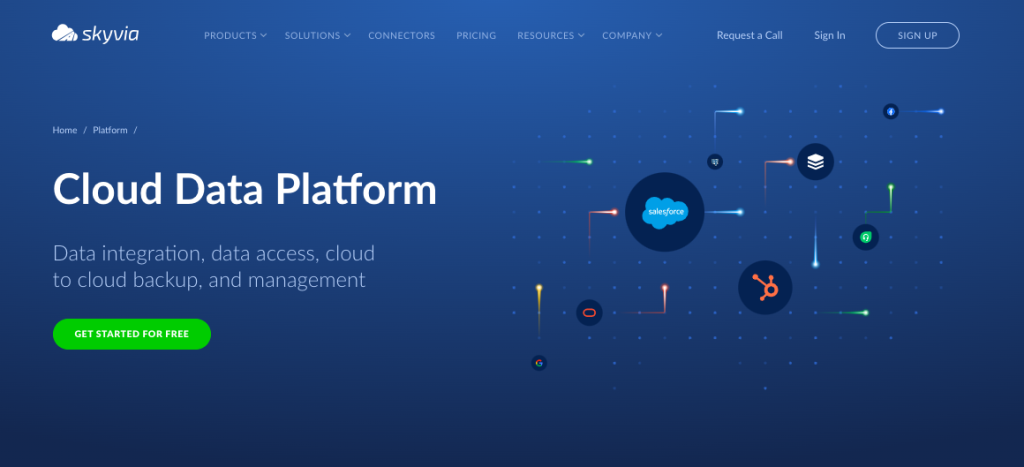
Skyvia is a cloud-based, no-code data integration platform with a user-friendly interface, rated among the Top 20 Easiest To Use ETL Tools by G2 Crowd. It offers various data integration scenarios and supports 180+ data sources, including cloud applications, databases, and data warehouses. It’s ideal for users looking for a no-code interface to connect their SaaS applications, databases, and cloud data warehouses without deep technical expertise.
Key Features
- Offers ETL, ELT, and Reverse ETL integration scenarios as well as flexible scheduling in addition to CDC.
- Provides secure data transfer with encryption and two-factor authentication.
Pros
- Easy to use.
- No installation is required.
- Versatile data management solutions.
Cons
- Depends on internet connectivity.
- More video tutorials would be helpful.
Pricing
The pay-as-you-go pricing offers a free tier; paid plans start from $15/month with offers based on features and data volumes. The paid functionality offers max execution frequency, scheduled integrations, source and expression lookup mapping and sync, data import, splitting, etc.
Debezium
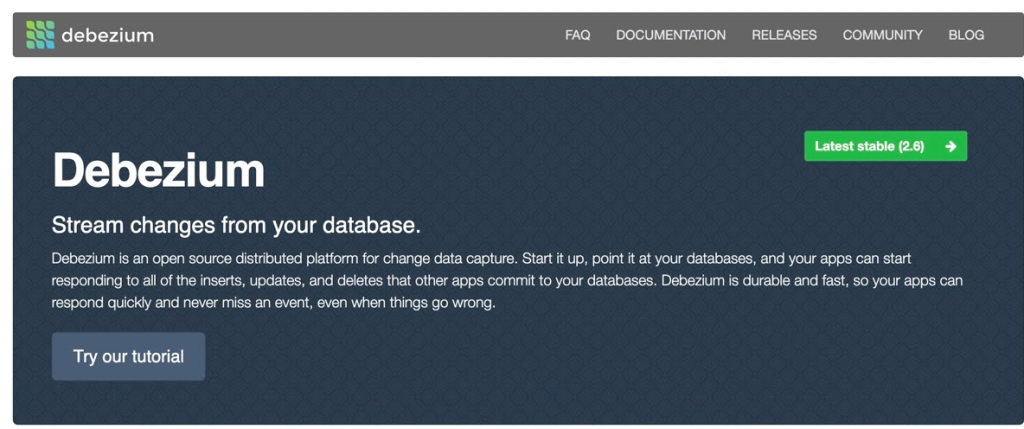
Debezium is an open-source CDC platform that streams database changes into Apache Kafka. It specializes in capturing real-time row-level database changes, turning your database into an event stream. It’s beneficial in microservices architectures where individual services must react to shared data store changes.
Key Features
- Native integration with Apache Kafka for real-time data streaming.
- Extensive database support, including PostgreSQL, MySQL, MongoDB, and SQL Server.
- Transparent handling of database schema changes.
Pros
- Wide database support.
- You can start and stop data apps as needed.
- It integrates well with Kafka ecosystems.
Cons
- It requires Kafka expertise.
- Setup can be complex.
Pricing
The solution is open-source, so it’s free to use. However, be careful with hidden costs.
Oracle GoldenGate
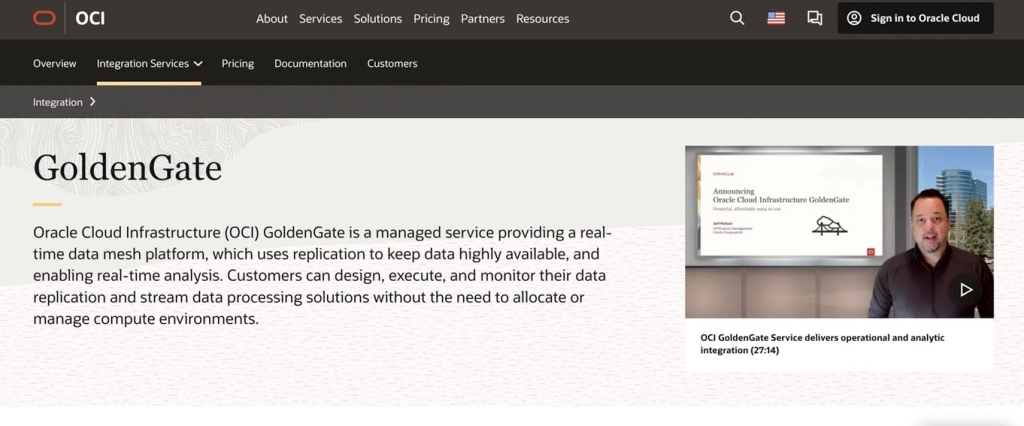
If searching for a comprehensive software package for real-time data integration and replication in heterogeneous IT environments, look at Oracle GoldenGate. The capability to support various platforms makes it a strong choice for complex, heterogeneous environments. This solution is often used in scenarios requiring minimal latency between source and target systems, like financial trading platforms.
Key Features
- Advanced conflict resolution mechanisms for complex replication scenarios.
- Detailed transaction data capture and delivery without impacting source systems.
Pros
- High-performance data replication and real-time data integration across heterogeneous databases.
- The solution supports various platforms beyond Oracle, including cloud services.
- It supports a broad array of databases.
Cons
- High cost.
- Complexity in setup and maintenance.
Pricing
Licensing costs start high, typically for enterprise use; specific pricing requires a quote from Oracle.
Apache NiFi
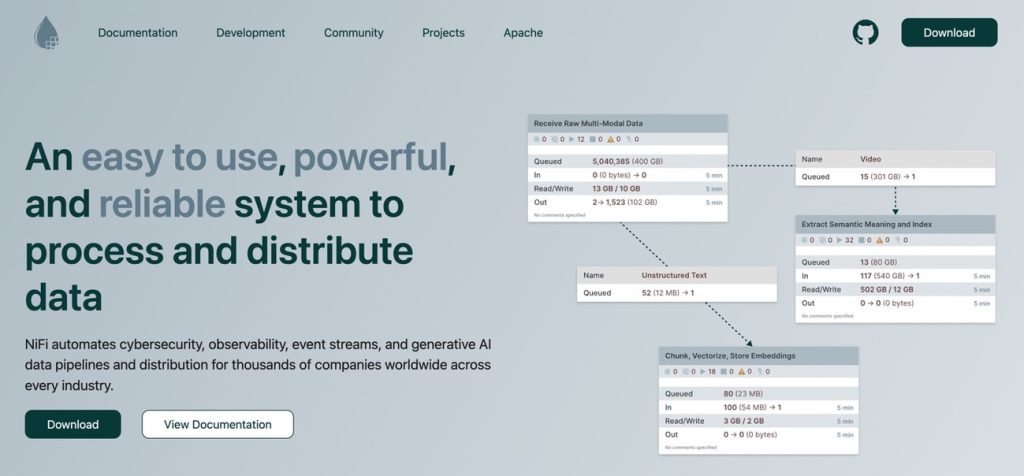
Designed by the NSA, Apache NiFi is an open-source software project that provides a web-based UI to automate data flow between systems. It includes data routing, transformation, and system mediation features, which is especially beneficial for data engineers looking to manage data movements visually.
Key Features
- The tool supports broad data sources and destinations with over 300 processors.
- It prioritizes data flow control with backpressure and prioritization mechanisms.
Pros
- Flexible and scalable graphical interface for designing, running, and monitoring data flows.
- The solution facilitates secure data routing, transformation, and system mediation.
Cons
- The learning curve for the data flow approach may be complex for small projects.
Pricing
The platform is open-source, so that you may use it for free.
Qlik Replicate
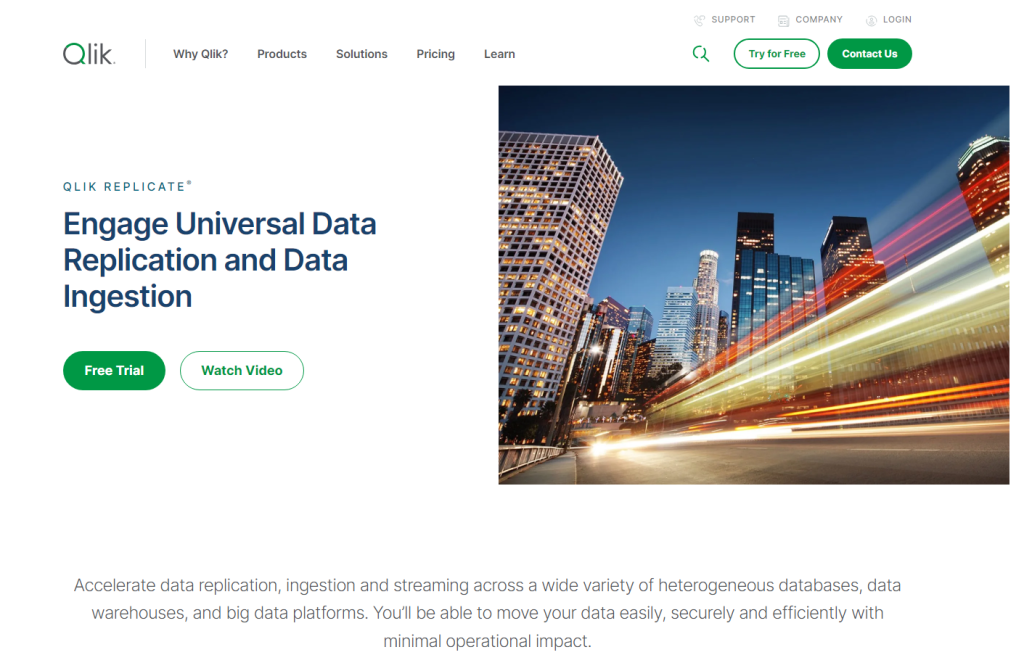
Qlik Replicate is a data integration and ingestion solution offering a straightforward, graphical approach to replicating, ingesting, and streaming data across various databases, data warehouses, and Hadoop. It minimizes the impact on source systems, which is vital for operational systems that cannot afford downtime.
Key Features
- Automated schema conversion and validation.
- Broad support for data sources and targets, including major databases and data warehouses.
- Minimal performance impact on source systems.
Pros
- User-friendly graphical interface.
- Efficient data replication.
Cons
- The solution can be expensive for small to medium-sized businesses and might require additional training.
Pricing
Pricing is flexible and depends on your business needs. Contact Qlik for a quote. And take into consideration a $350 per-user license fee and an additional $77 for software updates and support.
IBM InfoSphere Data Replication

IBM InfoSphere Data Replication provides real-time data replication and CDC capabilities that support a wide range of data sources and targets. Its integration with IBM’s analytics suite makes it a strong contender for businesses already invested in IBM’s ecosystem and looking to enhance their analytics and data governance strategies.
Key Features
- The tool supports data transformations and enrichments during replication.
- It provides robust conflict detection and resolution for bidirectional replication.
Pros
- Reliable performance.
- Extensive data source support.
Cons
- It can be complex to manage.
- The total cost of ownership is high.
Pricing
Pricing mode is custom and requires contacting IBM for details.
Striim
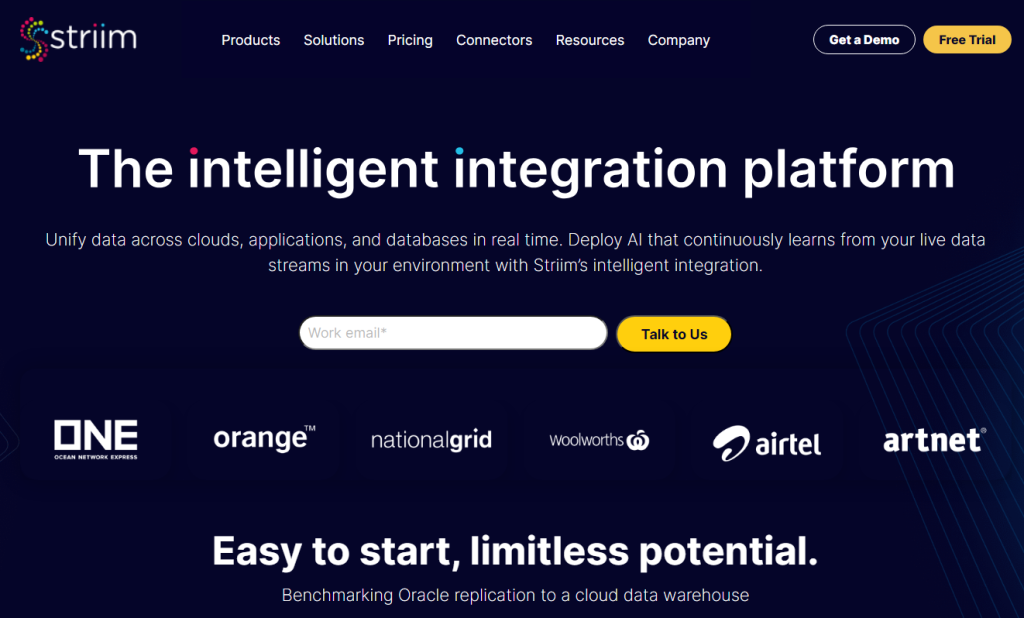
Striim is a real-time data integration solution providing streaming data ingestion, CDC, and analytics. It allows continuous query processing and streaming analytics, making it suitable for businesses that need to analyze data in motion for immediate insights, such as in IoT, e-commerce, and online services.
Key Features
- In-memory stream processing for fast data analysis and transformation.
- 100+ pre-built connectors for databases, cloud services, and data warehouses.
- Visualizations and dashboards for monitoring data flows and analytics.
Pros
- Real-time performance.
- Comprehensive integration features.
Cons
- Pricing transparency.
- The learning curve for streaming concepts.
Pricing
It is not publicly listed and requires engagement with Striim sales for a quote.
StreamSets
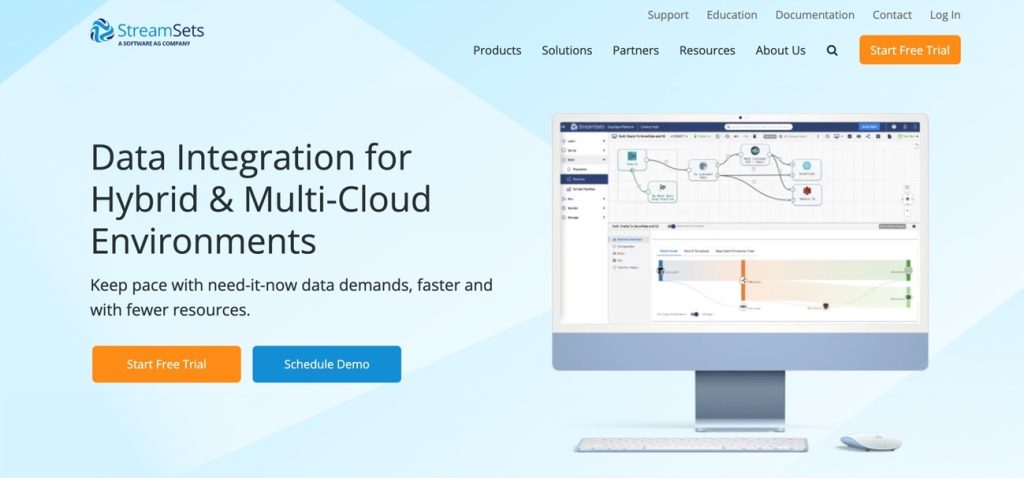
StreamSets is a platform for building continuous data ingest and processing pipelines that handle data drift—changes to the data structure, semantics, or infrastructure that can break pipelines. It’s a good choice for data engineers who need to manage evolving data sources without constant manual intervention.
Key Features
- Visual pipeline designer for easy creation and maintenance of data flows.
- The solution supports 100+ sources and destinations, including cloud-native services.
- Built-in performance monitoring and operational metrics.
Pros
- An ability to handle data drift automatically, adapting pipelines to schema changes.
- Extensive connector support.
Cons
- Overkill for simple needs.
- The tool requires time to learn.
Pricing
The pricing offers Professional and Enterprise editions. The Professional edition costs $1,000 monthly and allows running five active jobs on 50 published pipelines. The Enterprise edition isn’t limited to the number of jobs to run or the number of pipelines to publish. However, Enterprise edition pricing requires contacting StreamSets.
Talend
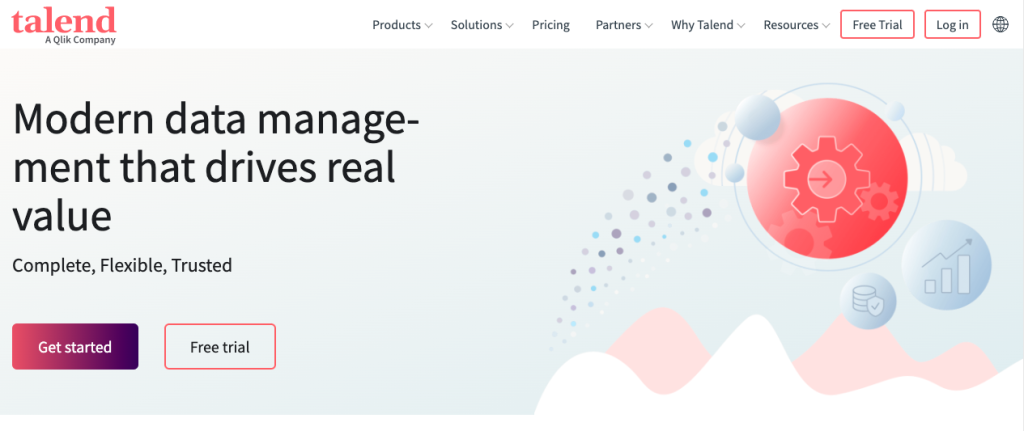
Talend offers a comprehensive suite of apps for data integration, quality, management, and big data. Its open-source foundation makes it accessible and provides robust enterprise solutions with advanced features for large-scale data projects. Its CDC works with Oracle, MS SQL Server, DB2, MySQL, and more databases. The solution suits businesses with complex data landscapes looking to consolidate their data integration efforts.
Key Features
- 1000+ connectors for various data sources and applications.
- It supports batch and real-time data processing.
- Open-source foundation with a strong community and enterprise support.
Pros
- Powerful ETL and data management capabilities.
- Open-source version available.
Cons
- The enterprise version can be costly.
- Steep learning curve.
Pricing
Open Source version is free; Talend Data Fabric (enterprise version) pricing is available upon request.
Hevo Data
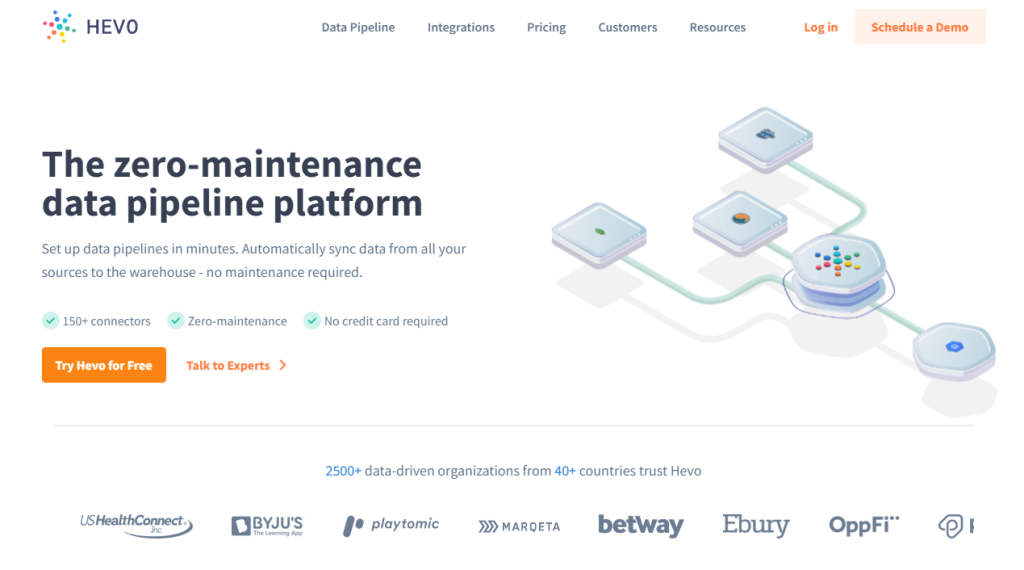
If you’re looking for a no-code data pipeline platform offering real-time data integration, transformation, and automation, Hevo is a good choice. It allows businesses to consolidate their data for analytics easily. It’s ideal for companies that prioritize ease of use and want to integrate disparate data sources quickly without a heavy engineering lift.
Key Features
- Hevo supports 150+ sources, including databases, SaaS applications, and cloud storage.
- It offers transformations with Python code for custom data processing needs.
- Real-time data load with schema detection and automatic mapping.
Pros
- User-friendly, no-code interface.
- An ability to identify data automatically.
Cons
- Pricing can be steep for high-volume data.
- Limited custom transformation control.
Pricing
Hevo offers a 14-day free trial; paid plans start at $239/month based on event volume and features.
Choosing the Best Change Data Capture Tool
To find the best CDC tool, you must clearly understand your business needs, including technical requirements, strategic objectives, operational constraints, etc. Define the use cases, appropriate connectors, data transfer and encryption capabilities, and real-time delivery. The price of the solution may also be a painful aspect of the selection.
Let’s review the most essential criteria to help you choose your solution.
| Criterion | Description |
|---|---|
| Compatibility with Source and Target Systems | Ensure the CDC tool supports your source databases (e.g., MySQL, PostgreSQL, Oracle) and target destinations (e.g., data warehouses, cloud platforms). Compatibility is crucial for seamless integration and data transfer. |
| Performance and Scalability | Evaluate the tool’s ability to handle your data volume and velocity without performance degradation. Remember about future growth and ensure the tool can scale to meet increasing data demands. |
| Real-time Processing Capabilities | If your use case requires immediate data availability for real-time analytics or operational reporting, assess the tool’s latency from change capture in the source system to availability in the target system. |
| Data Transformation and Enrichment | Some CDC tools offer built-in data transformation and enrichment features. Ensure that you need to preprocess data during replication and that the tool supports these functionalities |
| Ease of Use and Management | The tool’s user interface has to be easy to configure and maintain requirements. Tools with a steep learning curve or complex management can increase the total cost of ownership. |
| Reliability and Fault Tolerance | The ability to recover from failures and ensure data integrity is critical. To maintain data accuracy, look for features like checkpointing, automatic retries, and transaction consistency. |
| Security Features | Review the tool’s security mechanisms, including encryption, access controls, and compliance with standards like GDPR or HIPAA, especially if handling sensitive data. |
| Costs | Discover the pricing model (subscription, volume-based, perpetual license) and evaluate it according to your budget. Consider both initial costs and long-term expenses, including maintenance and support. |
| Support and Community | Assess the level of support provided by the community vendor for open-source tools. Access to expert assistance and a vibrant community can be invaluable for troubleshooting and best practices. |
| Integration with Existing Ecosystem | The CDC tool should integrate well with your existing data management ecosystem, including ETL processes, analytics platforms, and data governance tools, to enhance rather than complicate your data landscape. |
Conclusion
It’s complicated and tedious to support the CDC infrastructure with manual coding. It takes a lot of developers time they can spend on some tasks improving your business and saving your money. So, investing in some third-party CDC tool is a win-win solution.
Of course, the selection of such a tool depends on your company’s business scenarios. However, always consider the balance between the provided functionality, the solution’s usability, and cost savings.
